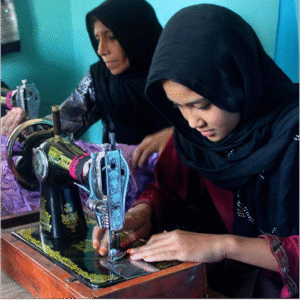19-year-old Mahnaz from the Afghanistan Newsroom explains the challenges threatening women’s involvement in the textile industry.

Afghan women sewing traditional garments in Balkh province, northern Afghanistan.
Picture by: Imago | Alamy
Article link copied.
August 1, 2025
Politics and social media threaten Afghan tailoring
For Afghan women, tailoring has long been more than just a profession – it has been a gateway to financial independence, self-expression and cultural preservation. Amid societal pressures and limited economic opportunities, tailoring has provided Afghan women with a means to support themselves and their families while maintaining a sense of creativity and purpose.
However, in recent years, two major challenges – economic restrictions and the rise of digital distractions – have threatened this traditional craft and the livelihoods of many women who rely on it.
Harbingers’ Weekly Brief
Skills and income
For generations, Afghan women have played a crucial role in the country’s textile and tailoring industries. Sewing and embroidery, once considered essential skills for young girls, was a path to financial stability for many women, especially those who could not access formal education or employment.
Afghan women who work from home have been central to the country’s textile and tailoring industries, practicing embroidery (such as khamak) and sewing traditional garments to support their families when formal employment was inaccessible. While male tailors also exist, women overwhelmingly dominate home-based tailoring and handicrafts, though men typically handle marketing and sales.
Women like Mariam*, a 45-year-old tailor from Kabul, who learned to sew at a young age and eventually turned her skill into a thriving business. “Tailoring has been my passion and my source of income for more than 20 years,” Mariam says. “It gave me the ability to provide for my children and gain respect in my community.”
But the challenges are immense. Political instability, economic crises and restrictions on women’s employment have made it increasingly difficult for female tailors to sustain their businesses. According to the UNDP (the United Nations’ global development network), women’s participation in the labour force dropped from 11% (2022) to 6% (2023). Consequently, many have been forced to work in secrecy or rely on underground networks to sell their products.
And now a new challenge threatens to pull young Afghan women away from this traditional craft.
Digital distractions
Beyond political and economic struggles, Afghan women now face another powerful obstacle – the rise of digital distractions. With smartphones becoming more accessible, social media, online shopping and digital entertainment have captured the attention of young women who might have once pursued tailoring as a profession.
Fatima*, a 22-year-old from Herat, grew up watching her mother sew intricate designs and dreamed of following in her footsteps. But now, she finds herself drawn more to online content than to her family’s sewing machine.
“I used to love learning embroidery from my mother, but now I spend most of my time watching fashion videos and scrolling through Instagram,” she admits.
“It’s easier to consume fashion online than to create it with my own hands.”
This shift in interest and focus has significant implications. As fewer young women take up tailoring, a centuries-old tradition risks fading away. The consequences go beyond cultural loss – without new generations of tailors, women lose a vital means of financial independence and empowerment.
Despite these challenges, many Afghan women are finding ways to merge tradition with modernity. Some have turned to social media to showcase their handmade designs, using platforms such as Instagram and Facebook to attract customers. Others are creating online communities where aspiring tailors can learn and share techniques.
For women like Mariam, the hope is that tailoring will not be forgotten. “Technology can be a tool, not a distraction,” she says. “If young women use social media to learn and promote their work, tailoring can survive and even thrive.”
The future of Afghan tailoring depends on finding a balance – one where tradition meets technology, and where the next generation of women can continue to sew their way towards independence.
* Names have been changed to protect identities
Written by:

Afghanistan
Contributor
LEARN Journalism Club
Illustration by Yuliia Muliar
Born in 2006, Mahnaz is currently studying journalism through the joint project between Harbingers’ Magazine and LEARN Afghan.
Mahnaz is preparing for the TOEFL (Test of English as a Foreign Language) exam and has completed the Lee’s English course at an advanced level. She also teaches English. She has completed a series of first-aid courses and is passionate about medicine and psychology, with a strong desire to become a surgeon in the future.
In her free time, Mahnaz enjoys playing football, watching cricket, reading books and watching English-language movies. She stays updated on current events by following the news.
Mahnaz is fluent in Pashto, Dari and English.
Due to security concerns the author’s image and surname have been omitted
Edited by:

🌍 Join the World's Youngest Newsroom—Create a Free Account
Sign up to save your favourite articles, get personalised recommendations, and stay informed about stories that Gen Z worldwide actually care about. Plus, subscribe to our newsletter for the latest stories delivered straight to your inbox. 📲
© 2025 The Oxford School for the Future of Journalism


